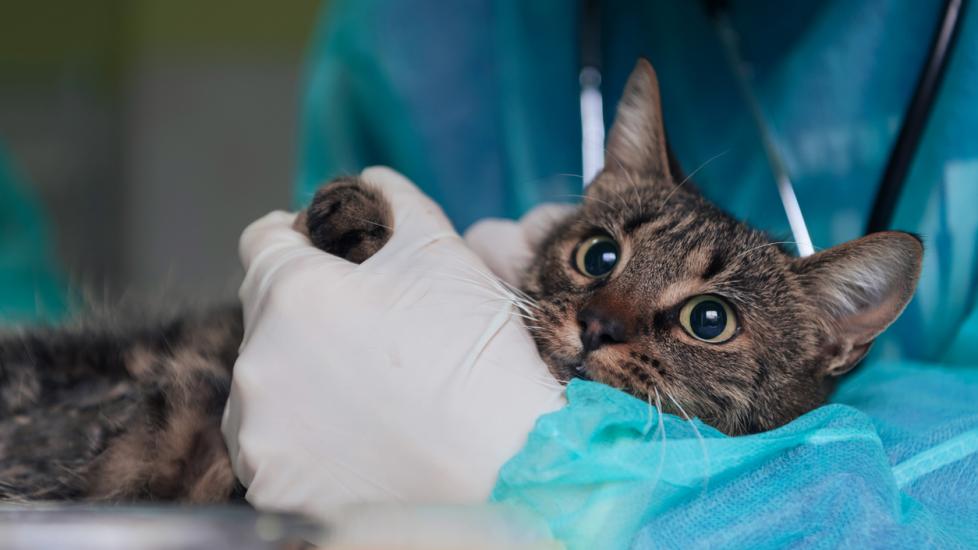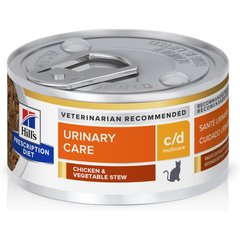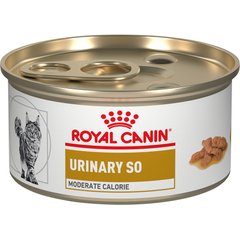Urinary Tract Blockage in Cats
iStock/.shock
What Is a Urinary Tract Blockage in Cats?
The medical term for a cat urinary blockage is urethral obstruction, since the urethra is the portion of the urinary tract where the blockage usually occurs. You may also hear this condition referred to as a “blocked cat.” Regardless of the term used, a urinary tract blockage means your pet can’t empty their bladder.
In normal cat anatomy, urine is produced in the two kidneys and travels down their respective tubes (ureters) to the bladder. When a pet is ready to urinate, the urine travels from the bladder down a single tube (urethra), through the penis in males and vulva in females, to the outside.
Urinary blockage occurs most commonly in male cats because the male urethra is skinnier than the female one and more prone to blockage.
Unless quickly corrected, this blockage can result in life-threatening consequences such as kidney failure, bladder rupture (tear), and dangerous electrolyte abnormalities that can affect the heart.
A urinary tract blockage in cats is a medical emergency, and any cat suspected to be blocked should be evaluated by a veterinarian immediately.
Health Tools
Not sure whether to see a vet?
Symptoms of a Cat Urinary Blockage
Urinary tract blockages can have symptoms similar to other urinary conditions. Feline lower urinary tract disease (FLUTD) is a blanket term used to describe urinary tract conditions in cats involving the urethra and bladder. Causes can include urinary tract infections, bladder stones, and inflammation (swelling).
One common cause of FLUTD is feline idiopathic cystitis (FIC). FIC is an inflammatory condition of the bladder that occurs secondary to stress.
FLUTD, FIC, and urethral obstruction can all result in similar clinical signs and make it difficult for the pet parent to determine which condition is affecting their cat. This determination is extremely important, because although FLUTD and FIC are typically not urgent, urethral obstruction can be fatal.
Common clinical signs noted with FLUTD, FIC, and the onset of urethral obstruction include:
-
Urgency to urinate (more frequent trips to the litter box)
-
Urinating smaller amounts more often
-
Straining to urinate (which can sometimes be confused with straining to defecate)
-
Urinating outside the litter box (often in strange places such as a bathtub, sink, or tile floor)
-
Licking the genital area
-
Vocalization (meowing loudly and often) as if in pain or distress
-
Lethargy/increased hiding
-
Decreased appetite
-
Vomiting/diarrhea
The defining sign of your cat having a urethral obstruction is straining to urinate with no urine production or only a few drops of urine produced.
It can be hard to tell, especially if your pet has been going to the litter box frequently or urinating outside the litter box in the house. Placing your cat in a small bathroom with a litter box for a few hours to check for any urine production may be the best way to determine if they are urinating.
If you are unsure your cat is producing urine, consider this an emergency, and have them evaluated by a veterinarian immediately. Life-threatening consequences can occur in as little as 12–24 hours of being unable to urinate. Death from untreated obstruction may occur in as little as 36–48 hours.
Causes of Urinary Tract Blockage in Cats
Common causes of urethral obstruction include:
-
Urethral plugs: These are the most common cause of obstruction in male cats. Urethral plugs are a combination of crystals and mucous formed by the body; they lodge in the urethra and prevent urine from exiting.
-
Bladder stones: These can move from the bladder and lodge in the urethra, causing urethral obstruction.
-
Stricture (narrowing of the urethra) and cancer: These are rare but possible causes.
-
Swelling: In up to 50% of cases, no definitive cause was found, but inflammation likely plays a role.
Any breed of cat is at risk for urethral obstruction, but males are more susceptible than females because they have a much narrower urethra. Cats that do not drink enough water may also be at higher risk.
How Veterinarians Diagnose a Feline Urinary Blockage
Your veterinarian will start with a complete medical history of your cat. Immediately share any information regarding straining, trouble urinating, or bloody urine.
Your veterinarian will perform a thorough physical examination of your cat, including palpating (touching) the abdomen to locate the bladder:
-
In a normal cat, the bladder should be small and soft, like a water balloon.
-
In a cat with FLUTD or FIC, the bladder is often extremely small and unable to be palpated since the cat has been urinating so frequently.
-
In a blocked cat, the bladder will be firm and hard like a baseball and will likely be painful on palpation.
The veterinarian may also attempt to gently squeeze the bladder with a small amount of pressure, but in most urethral obstructions, the bladder cannot be emptied this way. Palpation of the bladder is a key part of diagnosing a urinary tract blockage, but it should only be performed by a veterinarian.
If a cat is extremely obese or irritable, even a veterinarian may have trouble palpating the bladder and additional testing may be recommended. Abdominal ultrasound can be useful in evaluating bladder size and to check for bladder masses or suspected urinary crystals. An abdominal X-ray may be performed to see bladder size and check for bladder or urethral stones.
A complete blood count, serum blood chemistry, and urinalysis will all likely be recommended for further evaluation.
Treatment of Urinary Tract Blockage in Cats
Blocked cats must be unblocked. Treating a cat urinary blockage involves relieving the obstruction and treating a potentially fatal buildup of electrolytes and urinary toxins.
This is achieved by placing a urinary catheter while your cat is under sedation or anesthesia. Placing a urinary catheter in a blocked cat can be challenging, and possible complications include tearing the urethra and bladder rupture, which may result in the need for emergency surgery.
Thankfully, most cats are successfully unblocked, and a urinary catheter is sewn in place for the next three to five days. During this time, cats with significantly elevated potassium are often treated with calcium gluconate and/or insulin and glucose to decrease potassium levels and protect the heart.
The cat will be hospitalized on pain medication and IV fluids. Antibiotics and a prescription diet may also be prescribed. Once the obstruction is removed and pressure is relieved off the kidneys, kidney values usually return to normal. However, acute kidney failure is possible.
In most cases, medical management is considered the standard of care. However, if the cat has bladder stones or a previous history of urethral obstruction, your veterinarian may recommend surgery. Cystotomy is performed to remove bladder stones.
Perineal urethrostomy (PU) is a specialized reconstructive surgical procedure to create a wider urethral opening in a male cat, similar to a female, and prevent future urethral blockages. PU comes with risks and will not prevent future episodes or clinical signs of FLUTD or FIC. Your veterinarian can help advise you if PU is the correct treatment for your cat.
Recovery and Management of Urinary Tract Blockage in Cats
Early diagnosis and treatment are crucial for successful outcomes in urinary tract blockages in cats. Most cats will need to remain hospitalized for three to five days for IV fluids, pain medications, and other supportive care.
Once the urine becomes clear and recheck blood work has normalized, the urinary catheter can be removed, and your pet should be monitored for an additional 12-24 hours to ensure they do not get another blockage. They can typically be discharged once they are urinating on their own.
Once discharged from the hospital, your cat may be prescribed medications to help the urethra relax for up to two weeks, and they may be prescribed oral pain medications and antibiotics as needed.
A prescription diet will likely be recommended for the rest of their life to prevent and dissolve future crystal formation and promote bladder health by altering the pH of the urine. Increasing water consumption with waterfall waterers and a canned diet may also be recommended.
Commonly recommended products for a prescription diet include:
With timely and appropriate care, most blocked cats go on to live normal lives with small dietary changes, but pet parents should remain vigilant of their cat’s urination. More obstructions are possible, and if your pet has more than two episodes of urethral obstruction, it may be time to discuss PU surgery with your veterinarian.
Feline Urinary Blockage FAQs
1. How long can a cat live with a urinary blockage?
Life-threatening consequences can occur in as little as 12–24 hours of being unable to urinate. Death from an untreated obstruction may occur in as little as 36–48 hours.
2. Can a cat urinary blockage resolve itself?
No. If a cat is showing signs of a urinary blockage, they must be seen immediately by a veterinarian to confirm the blockage and have the blockage treated.
3. How do you unblock a cat’s bladder at home?
A cat’s bladder cannot be unblocked at home. Handling the bladder of a blocked cat should only be performed by a veterinarian. Squeezing or manipulating the bladder will not relieve a blockage and could lead to a life-threatening bladder rupture.
References
-
American College of Veterinary Surgeons.Urinary Obstruction in Male Cats.
-
Ettinger S, Feldman E. Textbook of Veterinary Internal Medicine, 6th ed. Elsevier Saunders; 2005.
-
Reineke E. “Feline urethral obstruction: Emergency treatment and stabilization.” Western Veterinary Conference 2013, Proceedings.


